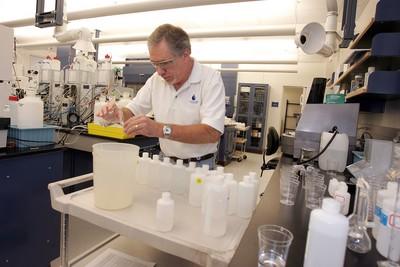TESTING THE WATER


Your tap water contains slightly more contaminants than it did a year ago, but you would have to be a highly sensitive piece of laboratory equipment to notice the difference.
Levels of arsenic, chromium and bromate have ticked up, according to the annual water quality report just released by the Las Vegas Valley Water District.
Even with the changes, local drinking water continues to be well within federal safety standards for all regulated contaminants.
Some of the increases seem alarming at first glance — arsenic more than doubled and bromate tripled — but the concentrations are so tiny that the change is almost negligible, said J.C. Davis, spokesman for the water district.
“You’ve got to have one of the best labs in the country to even tell the difference,” Davis said.
The level of chromium, for example, jumped from 1.5 parts per billion to 2.7 parts per billion, but the change is roughly equivalent to one extra drop of water in an Olympic-sized swimming pool. The federal safe drinking water standard for chromium is 100 parts per billion.
Some of the increase in contaminants is being blamed on the falling water level in Lake Mead, which continues to shrink amid seven years of record drought.
The Las Vegas Valley gets about 90 percent of its drinking water from the man-made reservoir. As the amount of water in the lake declines, the concentration of contaminants rises.
“Your intakes are closer to the surface, and the warmer water near the surface is where contaminants tend to get trapped,” Davis said. “Keep in mind, since 2000, the surface of the lake is 100 feet closer to our intakes.”
Not all contaminants are on the rise.
The level of perchlorate continues to fall amid efforts to clean up remnants of the rocket-fuel ingredient from several chemical plants in Henderson.
In 2004, valley drinking water contained an average of 8 parts per billion to 10 parts per billion of perchlorate.
Now the level stands at less than 2 parts per billion.
“That’s because you’re finally seeing the full effects of the Nevada Division of Environmental Protection’s efforts,” Davis said. “In other states, they’re still arguing about who’s going to clean it up. NDEP just stepped up and handled it.”
There is no federal safety standard for perchlorate, but Nevada has adopted an advisory standard of 18 parts per billion.
Davis said that until 1997, lab equipment was not sensitive enough to detect perchlorate in concentrations smaller than 40 parts per billion.
Overall, he said, “our water really is of excellent quality” from a scientific standpoint, but it isn’t going to win any awards for its taste.
Because most of the supply washes down from the Rocky Mountains in the silt-laden Colorado River, Las Vegas has some of the hardest water around, and the amount of chlorine used to treat it doesn’t help much with the flavor.
In fact, several of the contaminants found in valley water, including bromate, are byproducts of the disinfection process.
“People don’t like the hardness, and they don’t like the chlorine taste,” Davis said. “We can’t sacrifice safety for aesthetic quality.”
The district’s figures are based on more than 30,000 water samples taken from the valley’s two treatment facilities.
Under the federal Safe Drinking Water Act, utilities nationwide are required to report their water quality test results once a year.
REPORT IN THE MAILCopies of the 2007 Water Quality Report are being mailed to more than 487,000 homes and businesses served by the valley’s largest water utility. Those who do not receive the report by July 1 can get one from the district’s Web site, www.lvvwd.com, or by calling 258-3930.












